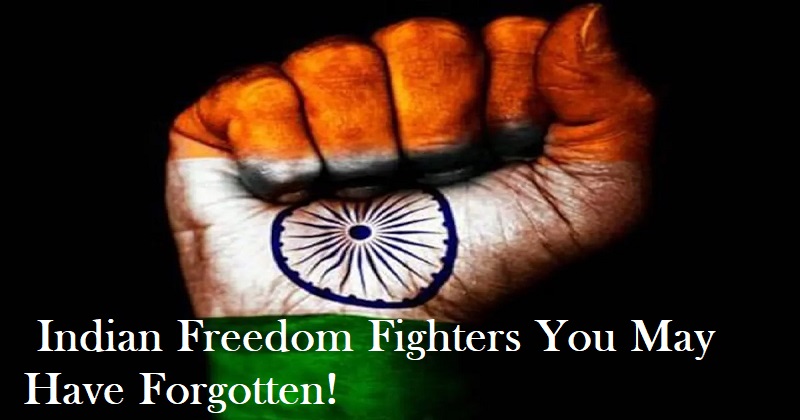
Millions of people fought a never-ending battle for Indian freedom. There is a long history of Indian warriors who fought for the cause of independence, albeit in different ways. Many have faded into history, while others have remained in the spotlight. The following are some of the freedom fighters whose contributions were and still are valuable. They certainly deserve to be recognized, even if they are not given the respect they deserve;
Tirot Sing- Tirot Sing was a Khasi chief. He is regarded as a hero by his tribe because he was killed while fighting the British during their takeover of the Khasi Hills.
Matangini Hazra- Matangini was an active member of the Quit India and Non-Cooperation Movements. During a Quit India movement protest, she was shot three times while marching with the Indian flag. Despite being shot, she continued to shout ‘Vande Mataram’. Gandhi Buri was her affectionate nickname.
Tara Rani Srivastava- She was a freedom fighter, who was actively involved in the Quit India movement alongside Gandhi. As a couple, she and Phulendu Babu participated in the movement in Saran, Bihar. In 1942, while leading a march to the police station in Siwan, her husband was shot by police. Despite this, she continued the march, only to return later and find her husband dead.
Kanaiyalal Maneklal Munshi- The name Kulpati was famously associated with him. During India’s freedom struggle, he was a key figure in the Quit India Movement. He founded the Bharatiya Vidya Bhavan. Despite being arrested several times, his passion for India’s freedom never wavered.
Garimella Satyanarayana- During the Indian national liberation struggle, Garimella inspired the people of Andhra Pradesh. Many of his poems and songs were written to inspire the people of Andhra to join the anti-British movement.
Tirupur Kumaran- The founder of the Desa Bandhu Youth Association. He organized several protest marches against the colonial government. On January 11, 1932, he was assassinated for carrying an Indian nationalist flag, which the British had banned. He died as a result of his injuries while still holding the flag.
Parbati Giri- Parbati Giri was a 16-year-old teenager who actively participated in all freedom activities, particularly the Quit India Movement. Parvati was also imprisoned for two years for her involvement in the national liberation movement. Giri continued to serve the public in a social capacity after independence. She was dubbed the ‘Mother Teresa of Western Orissa’.
Velu Nachiyar- Rani Velu Nachiyar reigned over the Sivaganga estate from approximately 1780 to 1790. She was the first Indian queen to fight valiantly against the East India Company. Tamils remember her fondly as Veeramangai.
Kamladevi Chattopadhyay- Kamaladevi was the first Indian woman to run for a legislative seat. She was the first Indian woman arrested by the British because of her active participation in the Indian freedom struggle. As a social reformer, she was instrumental in reviving handicrafts, theatres, and handlooms in order to improve the socioeconomic status of Indian women.
Veerapandiya Kattabomman – Veerapandiya was a Palyeakar chieftain from Tamil Nadu who fought Britishers in the 18th century. He refused to obey and oblige in the face of British tax hegemony. He was eventually apprehended and executed in 1799.
Surendra Sai- He was the crown prince of Sambalpur who defended western Odisha from the British. He urged the tribals in his area to understand and value their culture, as well as to resist colonial forces. He surrendered in 1862 and spent the next twenty years in prison, dying in obscurity.
Sido and Kanha Murmu- Sido and Kanha Murmu were two brothers from the Santhal tribe. On June 30, 1855, they led an armed rebellion of 10,000 armed Santhals against the British. Unfortunately, their success was short-lived because their weapons were primitive in comparison to the modern British armory.
Dinesh Gupta, Benoy Krishna Basu, and Badal Gupta- These young freedom fighters infiltrated Col. NS Simpson’s chambers disguised as Europeans. In 1930, he was assassinated at the Writers Building State Secretariat in Kolkata. They shot him because of his cruel treatment of the imprisoned freedom fighters and his cruelty as a tyrant. They committed suicide because they did not want to be found out. Benoy and Dinesh shot themselves with revolvers while Badal ingested cyanide. Following independence, the site of this incident became known as Benoy-Badal-Dinesh (BBD) Bag.
Conclusion
As India celebrates its platinum jubilee this year, 75 years of independence is a significant achievement. From the beginning, India has faced numerous challenges and upheavals. The fight for independence was not limited to a few isolated incidents. Every Indian who spoke out and fought back against the British made a concerted effort. Our awareness of the fact that many freedom fighters remain unrecognized has grown in recent years. It is not intended to be an exhaustive list, but rather to highlight the names that have been lost.
Sadly, many of these freedom fighters gave their lives very early and didn’t witness the dawn of 15th August 1947. Being able to identify our true fighters is beneficial for us as a nation, and they deserve our respect and adulation.

Post Your Comments